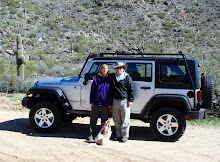I've been squeezing in a little work on the trailer between my other diversions. I sprayed in some foam around the front nose cap frame and the pink extruded foam board I installed last week. Here are a few shots of the foam around the nose cap area.


 The spray foam is for the purpose of locking the wooden frame into place so it won't shake around when driving down washboard roads. Also, I put it around the foam boards to seal them up to the frame. Another bonus is that by shooting some in around the wiring, it will keep it from chaffing against the front cap on rough roads.
The spray foam is for the purpose of locking the wooden frame into place so it won't shake around when driving down washboard roads. Also, I put it around the foam boards to seal them up to the frame. Another bonus is that by shooting some in around the wiring, it will keep it from chaffing against the front cap on rough roads.While I was standing there with a can of spray foam insulation in my hand, it seemed like a good time to shoot some foam into the space above the door header so I did that, also.
After I used up all the spray foam, I moved on to running the marker light wires through the angle brackets we welded into the frame for window supports.
I bought a standard RV porch light fixture and mounted it by the side door.
I chose a porch light without a switch on it, so that it could be turned on and off from a switch inside the trailer, making it less likely for someone to leave the light on and run the battery down. I wired up an inside switch just inside the door.
Next on my list was to hook up "shore power" to the trailer with a 30 amp power chord. I just happened to have a 30 amp extension chord from my RV laying around. It would work for the power chord, but the female connector doesn't meet the requirements of some parks that require power chords to be sealed "twist lock" connections, or to be hard wired into the RV. I found a 30 amp conversion kit at the local RV store that would give me the parts I needed to convert my power chord to a twist lock, and also the needed twist lock input jack for the trailer.
I also picked up a converter so I could plug my supply chord into a standard 15 amp plug whenever I needed to. After cutting off the extension chord's female plug and installing the twist lock sealed plug, my chord was built.
The standard place for a park to put in the power box for electrical hookups is the the driver's side at the rear of the trailer. I drilled a 2 3/4" hole in the lower rear of the driver's side, and mounted the power input jack
The kit came with a good strain relief and cover for the back of the jack. After the panelling is installed around this, I'll build a small kick out box to protect the back of the plug and the 10 gauge wiring going into it.
Now, I'm ready to finish the insulation, then put the panelling back in. Hopefully there will be less interruptions, and I can move along more quickly.
Gil










No comments:
Post a Comment